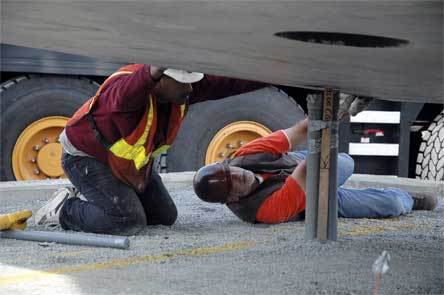MARYSVILLE — Three months after its groundbreaking, the Community Transit park and ride station at the intersection of Cedar Avenue and Grove Street celebrated another milestone Oct. 12, as contractors installed the park and ride station’s prefabricated lavatory building at the southeast corner of the station’s approximately two-acre lot.
Marysville Mayor Dennis Kendall donned a hardhat and safety vest to join Community Transit Chief of Strategic Communications Todd Morrow and Capital Facilities Project Manager Joe Brown at the site at 9 a.m., as they watched a crane lift the lavatory from a flatbed trailer and set it in place, to line up with its electrical and plumbing fixtures.
“It’s good to see this project on schedule and on budget,” said Kendall, who joked about wanting to “christen” the lavatory.
Brown explained that the major remaining steps in the station’s construction include installing security cameras and lights, and paving concrete walkways and parking lot blacktop, the latter of which is expected to happen the week of Oct. 19. In the meantime, the commuter shelter is currently being prefabricated.
“It’s all on target,” Brown said.
Morrow estimated that the station could be dedicated as early as mid-December, although he cautioned against treating this as a hard-and-fast date.
“This is a terrific site,” Morrow said. “It’s flat, there are no wetland issues, and it serves existing routes so those won’t have to change.”
The Cedar Avenue and Grove Street lot was selected as the best of 20 possible sites for the park and ride station due to its location one block west of State Avenue where four local routes operate frequent service. Its flat terrain makes it easier to develop.
The park and ride station will include 213 parking spaces, with additional parking for motorcycles and bicycles, and room for up to three buses. Its construction utilizes reusable and recycled materials, trees will be planted on site, and storm water will percolate through the ground on site, with an on-site garden set aside for storm water overflow.
Federal funding will cover 80 percent of the station’s $4 million total cost, or $3.2 million.



